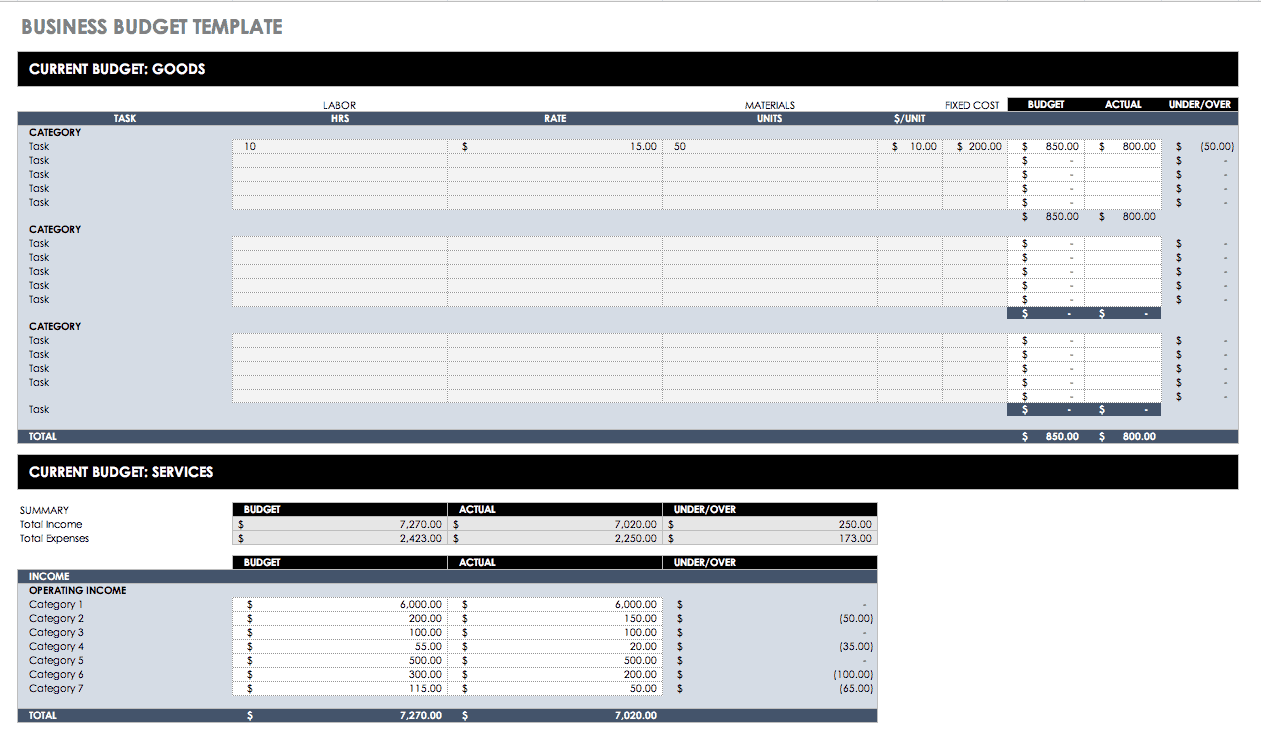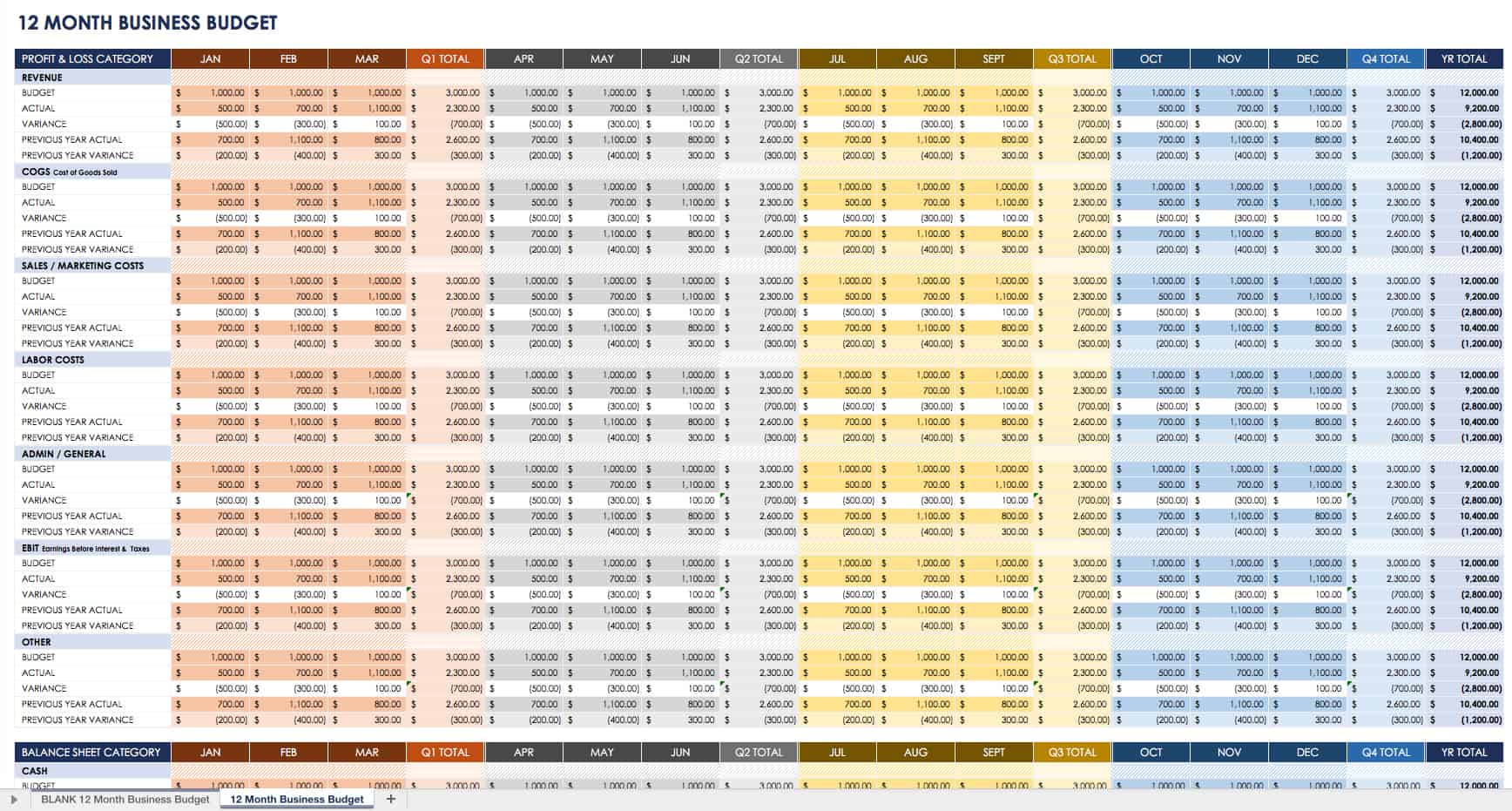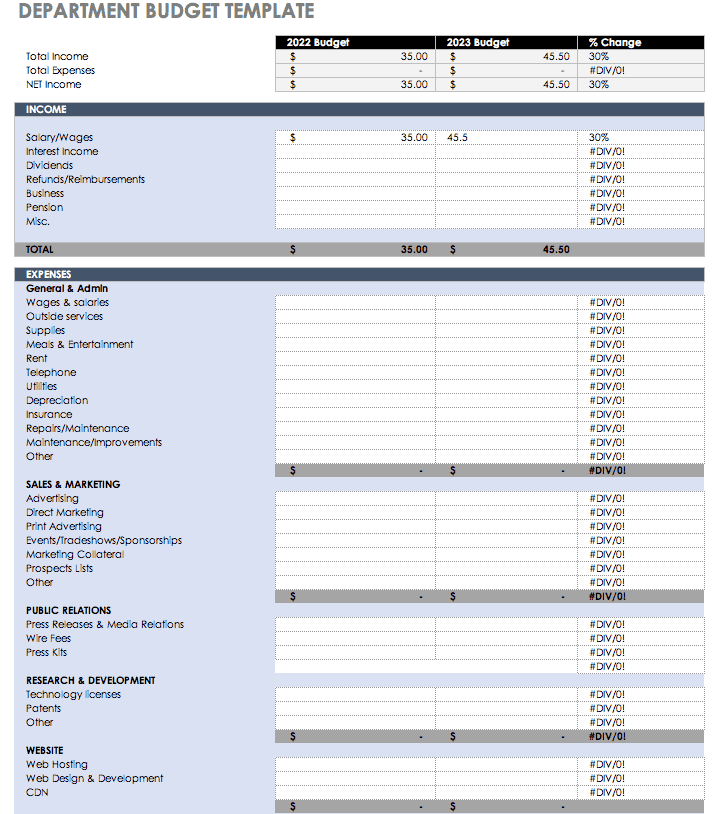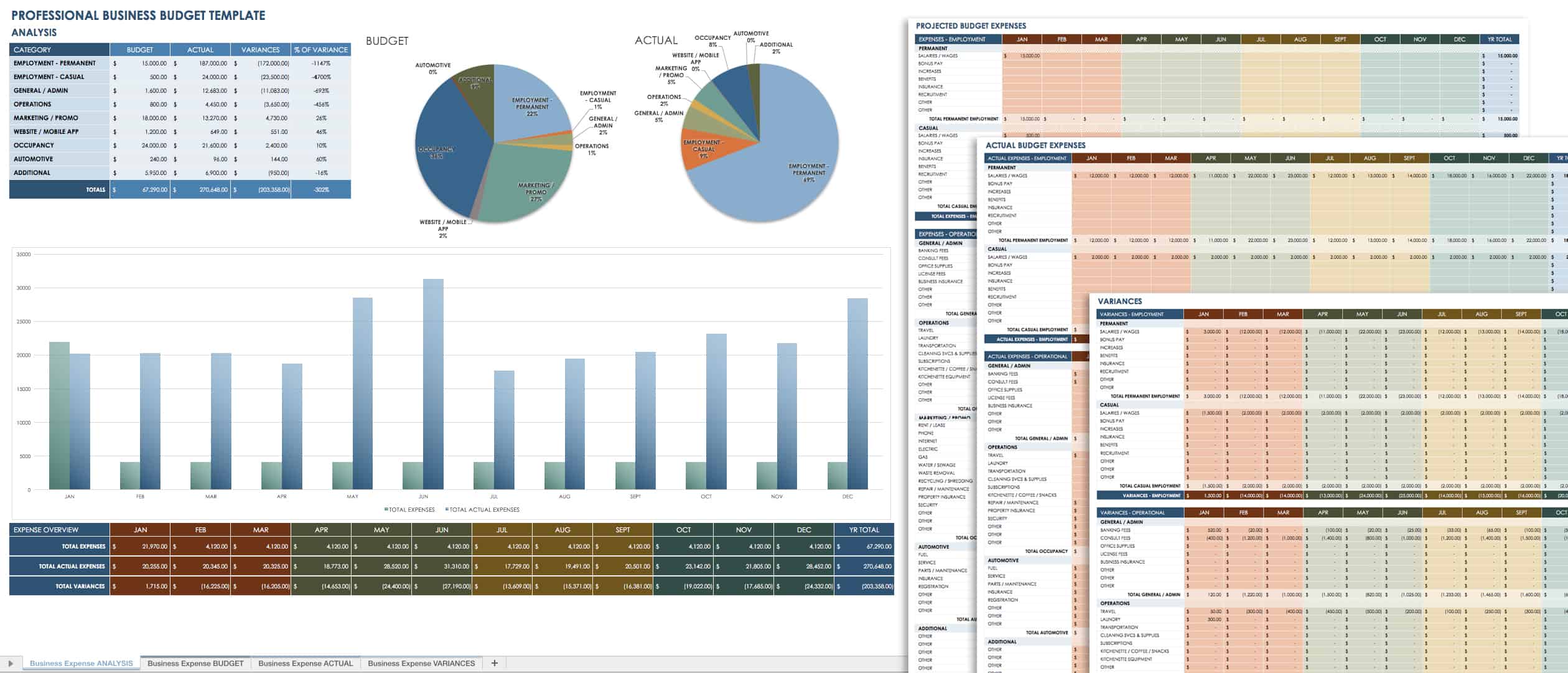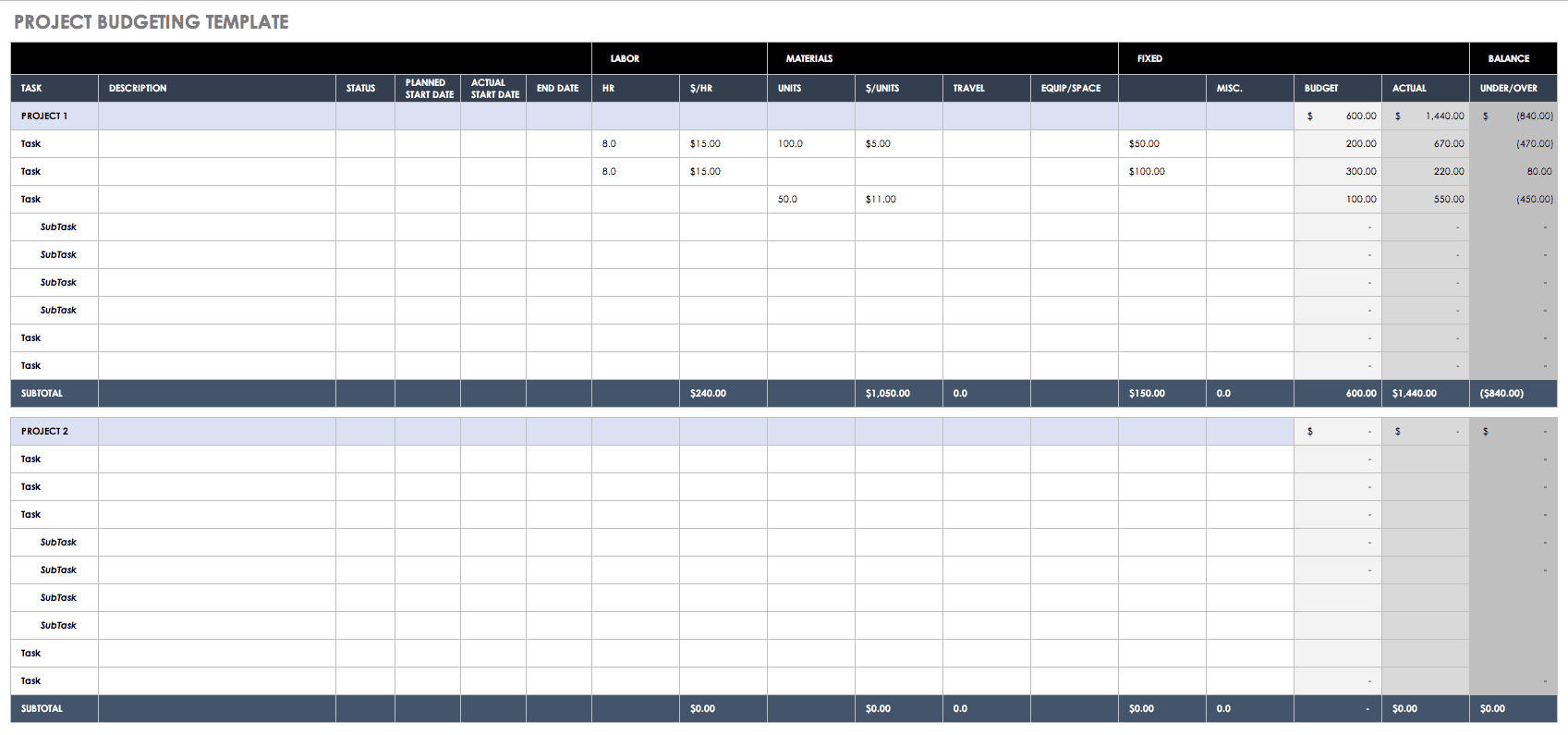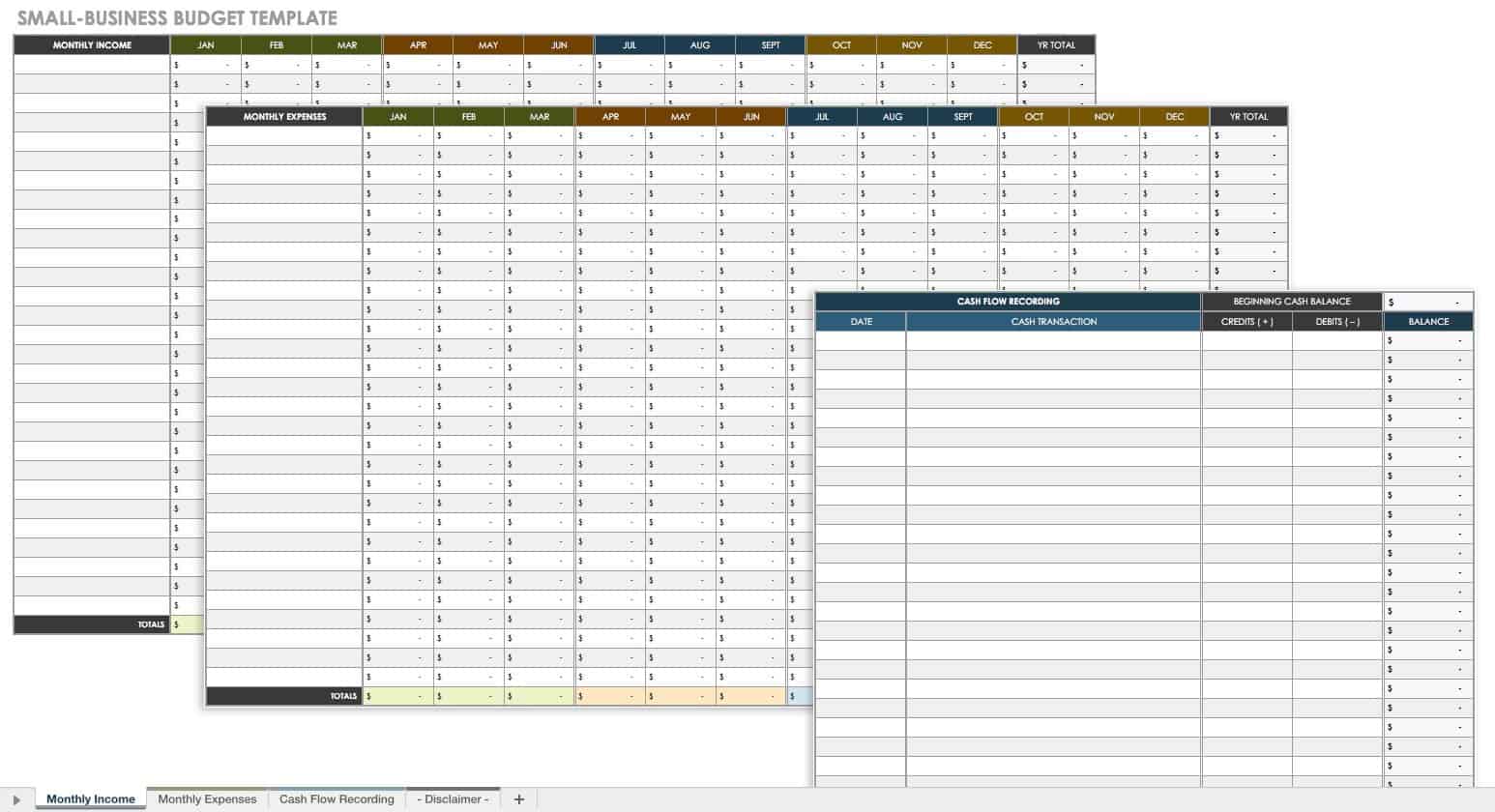Business Budget Template
Use this basic business budgeting template to track monthly income and expenses for companies of any size. This template has separate sheets to create budgets for either services- or goods-based businesses. Income and expenses are also broken down by category to provide a closer look at where company funds are made and spent.
12-Month Business Budget Template
For a more detailed view of your company’s financials over time, use this business budgeting spreadsheet. Enter your revenue and expense estimations for each month and the entire year. Then, add your actual income and expenditures month by month to see how closely you’re meeting your budget (the accuracy of your estimates). Income and expense categories are broken out, so you can clearly see where funds are going to and coming from.
Department Budget
To make sure your department is staying within its allotted budget, use this Excel business budget template. It allows you to plot yearly income and expenses for a company or academic department, and compare the percentage change year over year. View revenue and expense subtotals by category to see where you can make cuts, and identify any surpluses.
Detailed Financial Projections Spreadsheet
For larger, more complex businesses, you need more comprehensive business budget plans. This detailed spreadsheet tracks all the information you need to make important financial decisions — from startup costs to sales and operating expense forecasts. Estimate and track payroll costs, accounts payable and receivable, the cost of goods sold, lines of credit, and monthly fixed costs. You can also compare year-end totals against one another.
First-Year Budget Calculator
If you’re getting ready to launch a startup, a small business budget template can be a useful tool. This basic calculator can help you quickly gauge costs for your new venture and estimate your first-year business income. It also includes a column for plotting monthly personal expenses, along with available cash from savings and other sources. This way, you can estimate the amount you’ll need to get your new business off the ground.
Professional Business Budget Template
Download Professional Business Budget Template
This comprehensive budget template is ideal for larger, more established businesses: it offers one sheet for estimated expenditures (labor costs, office expenses, marketing spending, travel fees, etc.), and another sheet to plot expenses that accrue. It also allows you to track expense variances and offers charts for analyzing how closely your business is adhering to its budget.
Project Budget Template
Need to create a specific, detailed budget for a particular job? This business budget worksheet can help you track income and expenses at the individual project level. Calculate labor, materials, and fixed costs for individual tasks across different categories, and compare estimated against actual expenses and revenues. Keep per-project spending under control with this business budget spreadsheet.
Small Business Budget Template
If you run a small business or are self-employed, use this small business budget template to track and manage your finances. This basic budget planner has one sheet for tracking income sources, one for expense types, and another for cash transactions. Easily track monthly income and expenses and calculate total profits.
Start-up Budget Template
Download Start-up Budget Template
Are you opening a new business? Using small business budgeting templates can help you manage finances properly from day one. If you plan effectively, you’ll lay a strong economic foundation for your company as it grows. This small business budget template allows you to track estimated versus actual funding sources and amounts, determine pre-opening costs, and calculate ongoing expenses so you’ll know how much income you need to come out ahead.
What’s in a Business Budget?
According to the U.S. Small Business Administration (SBA), a business budget should contain the following information:
- Expected sales and revenues
- Fixed costs (those that don’t depend on sales, such as rent and business license expenses)
- Variable costs (items related to sales, such as materials and production expenses)
- Semi-variable costs (those that may or may not change depending on sales, such as wages and marketing fees)
- Profits (expected sales and income minus costs)
You may also choose to include additional information in your budget, depending on your business size and the level of financial information you want to track. For example, if you run a startup, you may want to include data on the total cost of getting your business up and running, as well as the amounts and sources of investor funding. If you have a large enterprise with multiple branch offices, you may want to create separate sheets for each location, as well as for the company’s overall budget.
How to Create a Business Budget Plan
When creating your initial budget, you can use a business budget template to help calculate revenues, expenses, and profits. You may also choose to purchase business budget software to create a more detailed plan. Whatever method you choose, follow these basic steps when forming a budget:
- Gather historical information: If you have an established business, collect historical data on operating expenses, salaries, sales, and revenues over time. If you’re starting a new business, look for financial information on a business similar to yours (in size and type) and use it as a benchmark.
- Estimate sales and set profit goals: Calculate the sales you expect to make during different times of the year, factoring in holidays, office or plant closures, and seasonal booms and lulls. Set profit goals, and make realistic revenue projections for the year and into the future.
- Determine fixed and variable costs: Calculate all the fixed costs involved in operating your business such as rent, insurance, and business licenses. Also determine estimates for your variable costs, including materials and equipment, labor, salaries for company executives, employee benefits, and training and travel expenditures.
- Calculate your profit margin: To determine how much profit you expect the business to make, subtract your expenses from estimated sales and revenues. Include the total cost of goods sold (the total amount it costs to produce your product or service), and factor in other costs like shipping, equipment, and materials for your office or production facility.
- Adjust your budget over time: Continually update your budget over time to see how your estimates compare with actual sales and expenses. If you’re not making a profit, try adjusting your budget to increase revenues and decrease overhead costs.
Discover a Better Way to Manage Business Expenses and Finance Operations
Empower your people to go above and beyond with a flexible platform designed to match the needs of your team — and adapt as those needs change.
The Smartsheet platform makes it easy to plan, capture, manage, and report on work from anywhere, helping your team be more effective and get more done. Report on key metrics and get real-time visibility into work as it happens with roll-up reports, dashboards, and automated workflows built to keep your team connected and informed.
When teams have clarity into the work getting done, there’s no telling how much more they can accomplish in the same amount of time. Try Smartsheet for free, today.
